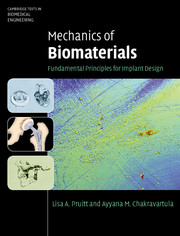Book contents
- Frontmatter
- Contents
- Symbols
- Prologue
- Part I Materials
- Part II Mechanics
- 6 Elasticity
- 7 Viscoelasticity
- 8 Failure theories
- 9 Fracture mechanics
- 10 Fatigue
- 11 Friction, lubrication, and wear
- Part III Case studies
- Epilogue
- Appendix A Selected topics from mechanics of materials
- Appendix B Table of material properties of engineering biomaterials and tissues
- Appendix C Teaching methodologies in biomaterials
- Glossary
- Index
- References
11 - Friction, lubrication, and wear
from Part II - Mechanics
Published online by Cambridge University Press: 05 June 2012
- Frontmatter
- Contents
- Symbols
- Prologue
- Part I Materials
- Part II Mechanics
- 6 Elasticity
- 7 Viscoelasticity
- 8 Failure theories
- 9 Fracture mechanics
- 10 Fatigue
- 11 Friction, lubrication, and wear
- Part III Case studies
- Epilogue
- Appendix A Selected topics from mechanics of materials
- Appendix B Table of material properties of engineering biomaterials and tissues
- Appendix C Teaching methodologies in biomaterials
- Glossary
- Index
- References
Summary
Inquiry
You are designing a total knee replacement – a high-load device for which wear is a major concern. What would your ideal materials be for a low-wear device? Are there other concerns at play here, and how do they affect your material selection?
The inquiry posed above gives an idea of the issues that must be balanced in medical device design. A total knee replacement will see contact stresses of 40 MPa (Bartel et al., 1986) and will undergo 1 million fatigue cycles per year. We have already discussed the dangers of stress shielding which can occur when using high stiffness materials. Selecting a material that can meet these demands and still maintain low amounts of wear is a challenge that must be tackled by a team of engineers and scientists.
Overview
When thinking about designing devices that will have contact with any other materials, it is necessary to consider issues of friction, lubrication, and wear, also known as the field of tribology. These are particularly critical in load-bearing medical device applications such as total joint replacements, where the generation of wear debris is a known issue that begins a cycle of immune response and the eventual need for device replacement. Frictionless contact would be ideal, but does not exist in the real world. It has also been shown that low-friction contact can still lead to appreciable wear (Stachiowak and Batchelor, 2005). In orthodontic implants such as braces, a smooth surface to the arch wires is very important – frictional forces are known to reduce the amount of force applied to the teeth by 50% or more (Bourauel et al., 1998 ). The characterization of the interface between two surfaces, including the composition of the articulating materials, the surface finishes, and the lubricant (if any) will play a large role in determining the friction and wear behavior.
- Type
- Chapter
- Information
- Mechanics of BiomaterialsFundamental Principles for Implant Design, pp. 369 - 394Publisher: Cambridge University PressPrint publication year: 2011



